Organisations should be making the health and wellbeing of their staff a core priority, and using interventions like physiotherapy to help people return to work.

This is according to new guidance on workplace health, published by the National Institute for Health and Care Excellence (NICE).
It covers how to help people return to work after long-term sickness absence, reduce recurring sickness absence, and help prevent people moving from short-term to long-term sickness absence.
The guideline emphasises that all employers should have measures in place to ensure a ‘smooth and sustainable’ return to work for people who are returning after a long period of absence. And for those who have been absent with musculoskeletal conditions, NICE advises that a programme of physiotherapy-led graded activity should be considered as a suitable intervention.
Physios can offer advice and support
Welcoming the guidance, CSP professional adviser Helen Harte said: ‘We recognise how important it is to support people to safely transition back into work after illness or injury, and physiotherapy has a key role to play.
‘Physiotherapists are expertly placed to offer advice and support for employees and employers on work health.
‘We urge all of our members to engage in conversations about work in routine consultations, and to start using the AHP Health and Work Report in everyday practice.
‘The AHP Health and Work Report is a helpful mechanism through which we can support employees in returning to work, or in receiving Statutory Sick Pay.'
The AHP Health and Work report, and guidance from the CSP on how to use it, is available here.
Ms Harte added that: ‘We have some exciting training and development resources in the pipeline for members via the physiotherapy professional network, the Association of Chartered Physiotherapists in Occupational Health and Ergonomics, and we were thrilled to deliver a programme theme on Fit for Work at our annual conference, Physiotherapy UK 2019.’
Find Out More
Number of subscribers: 1



































